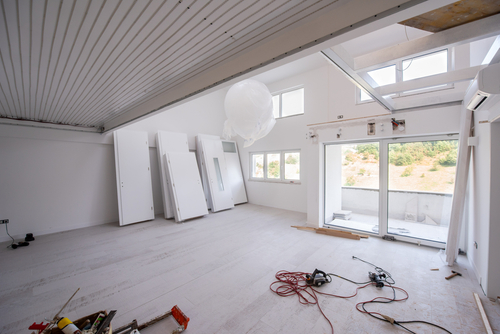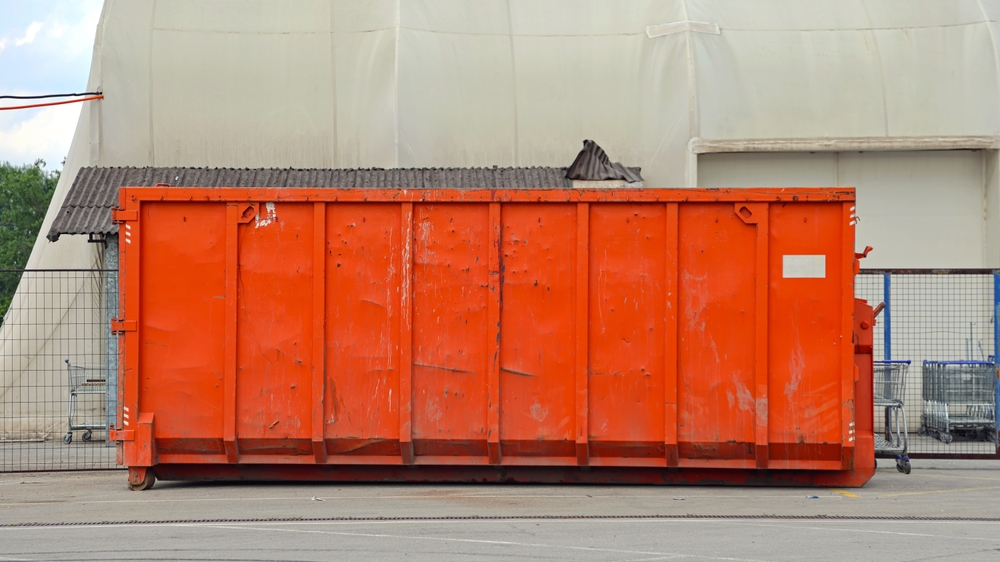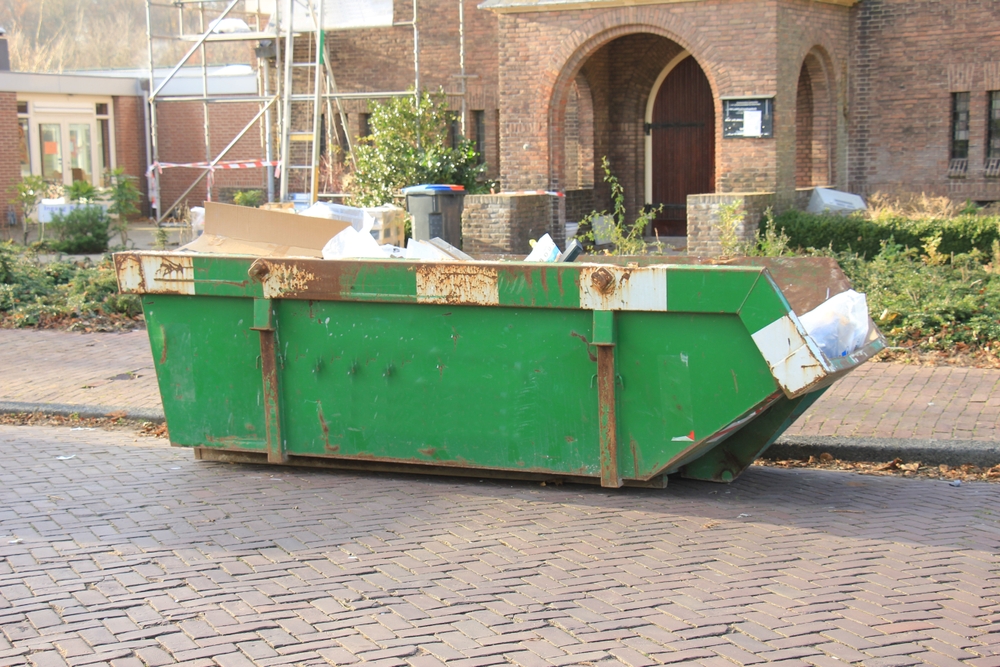June 28, 2024 - Benjamin Ehinger
How to Reduce Waste During Home Renovations: Practical Tips for a Greener Home
CALL NOW 844-762-8449
Tackling a home renovation can be an exciting endeavor, but it often comes with the challenge of managing waste. The good news is, by making mindful choices, you can significantly reduce waste and make your renovation more sustainable. Repurposing existing materials, opting for mindful deconstruction, and carefully selecting new materials are effective strategies to reduce waste during home renovations.
One effective approach is to donate or sell unused materials instead of discarding them. Many local organizations and online platforms can help you find new homes for these items. This not only reduces landfill waste but can also benefit others in your community. Of course, the things that need to be tossed out should be disposed of in a home dumpster rental, so they go to the proper place.
Another key method is to integrate eco-friendly strategies such as choosing durable materials that need less frequent replacement and repurposing what you already have. These steps ensure your renovation adds value without contributing to environmental harm.
 Effectively managing materials during home renovations reduces waste and minimizes environmental impact. The primary focus is on selecting sustainable building materials and utilizing recycled and reclaimed materials.
Effectively managing materials during home renovations reduces waste and minimizes environmental impact. The primary focus is on selecting sustainable building materials and utilizing recycled and reclaimed materials.
 When undertaking home renovations, one effective way to reduce waste and give items a new life is by donating or selling them. This approach not only helps the environment but also allows you to declutter responsibly.
When undertaking home renovations, one effective way to reduce waste and give items a new life is by donating or selling them. This approach not only helps the environment but also allows you to declutter responsibly.
 Incorporating eco-friendly elements like low-VOC paints and effective insulation not only benefits the environment but also enhances your home’s energy efficiency and indoor air quality.
Incorporating eco-friendly elements like low-VOC paints and effective insulation not only benefits the environment but also enhances your home’s energy efficiency and indoor air quality.
Key Takeaways
- Repurpose and deconstruct mindfully to reduce renovation waste.
- Donate or sell unused materials to minimize landfill contributions.
- Choose durable, eco-friendly materials for a sustainable renovation.
Planning Your Eco-Friendly Renovation
Creating a sustainable renovation plan involves careful consideration of materials and design, as well as selecting contractors with green expertise. These steps help ensure that your renovation is both environmentally friendly and cost-effective.Assessing Materials and Design for Sustainability
Begin with assessing the sustainability of the materials and designs for your renovation. Sustainable materials such as reclaimed wood, bamboo, and recycled metal can significantly reduce the environmental impact of your project. Choose materials that have low-VOC (Volatile Organic Compounds) emissions, which improve indoor air quality. Make informed choices about your design. Consider features like energy-efficient windows and insulation, which can save on heating and cooling costs. Water-saving fixtures are another essential element, contributing to lower water consumption and bills. Choose designs that incorporate natural light to reduce the need for artificial lighting during the day.Choosing the Right Contractor with Green Expertise
When it comes to renovating sustainably, having the right contractor is crucial. Look for contractors who have experience with eco-friendly projects. Ask for references and examples of past work that emphasize sustainability. Experienced green contractors can offer valuable advice on reducing waste and using sustainable materials efficiently. Involve an architect who specializes in sustainable designs to maximize the eco-friendly potential of your renovation. Ensure they understand and prioritize your sustainability goals. Collaboration with professionals skilled in green building practices will help you navigate the complexities of an eco-friendly renovation, ensuring that your project is both sustainable and successful.Source Reduction Strategies
Effective waste reduction in home renovations involves minimizing material usage and integrating efficient energy designs. These strategies not only reduce waste but also enhance energy efficiency and save money.Reducing Material Usage
Reducing the amount of materials used during renovations significantly cuts down on waste. One way to achieve this is by opting for deconstruction instead of demolition. This approach involves carefully taking apart structures to salvage materials for reuse or recycling instead of sending them to a landfill. Reusing materials like doors, windows, and fixtures can save both resources and costs. Another tactic is to prioritize using prefabricated materials and components. Since these are manufactured to precise specifications, they can reduce on-site waste. Moreover, these materials are often made from recycled content, which further supports waste reduction efforts. Additionally, you should measure and cut accurately to avoid surplus material waste. Leftover materials, such as wood and tiles, can often be repurposed for other projects or donated to organizations that support building efforts in underserved communities.Incorporating Efficient Energy Design
Integrating an efficient energy design into your renovation helps in reducing energy consumption and sustainability. Upgrading to energy-efficient appliances like LED bulbs and low-consumption heating systems can substantially lower energy use. It’s worth noting that nearly 92% of homeowners incorporate these features during kitchen renovations. Maximizing natural light and ventilation reduces the need for artificial lighting and cooling, further conserving energy. This can be done through strategic window placement and the use of skylights. Another important strategy is enhancing insulation and air sealing. Using eco-friendly insulation materials like recycled denim can improve your home’s thermal performance, reducing heating and cooling needs. Proper air sealing prevents energy loss, making your home more efficient and comfortable. Efficient energy design not only promotes sustainability but also leads to long-term cost savings on utility bills.Materials Management
 Effectively managing materials during home renovations reduces waste and minimizes environmental impact. The primary focus is on selecting sustainable building materials and utilizing recycled and reclaimed materials.
Effectively managing materials during home renovations reduces waste and minimizes environmental impact. The primary focus is on selecting sustainable building materials and utilizing recycled and reclaimed materials.
Selecting Sustainable Building Materials
Choosing sustainable building materials is critical. Choose materials that are durable and have a long lifespan. Products made from renewable resources, such as bamboo or cork, are excellent options. Energy efficiency in manufacturing is another factor. Look for materials produced using minimal energy and resources. Certifications like FSC for wood or Cradle to Cradle for other building products can guide your decisions. Consider low-emission materials. Items like low-VOC paints and sealants reduce indoor air pollution. Manufacturers that utilize minimal packaging are also preferable as they contribute less to landfill waste.Utilizing Recycled and Reclaimed Materials
Incorporating recycled and reclaimed materials into your renovation can add unique character to your home. These materials often come from salvaged building projects or repurposed items. Reclaimed wood can be used for flooring or furniture. It not only reduces the demand for new lumber but also lends a rustic charm. Recycled metal and glass can be transformed into fixtures, countertops, and decorative elements. Another option is to source materials from demolition sales or architectural salvage yards. Items like old bricks, doors, and windows can be reused, giving them a new life and reducing the need for new production. Reusing existing materials in your home, such as cabinets and fixtures, also minimizes waste and supports sustainability.Waste Minimization Techniques
Minimizing waste during home renovations involves strategic planning and mindful practices. Implementing a waste management plan and choosing deconstruction over demolition can significantly reduce waste and conserve resources.Implementing a Waste Management Plan
A waste management plan is crucial for minimizing waste. Start by identifying materials that can be recycled, reused, or donated. Designate separate bins for different types of waste such as wood, metal, and plastics. List and consider eco-friendly practices, such as selecting sustainable materials and reducing material packaging. Utilize local recycling centers for materials like metal and glass. Track your waste output to identify areas for improvement. Collaborate with your contractor to ensure adherence to the plan. Engage with organizations that accept material donations. Habitat for Humanity, for instance, often takes building materials for their projects. This keeps materials out of landfills and supports community efforts.Deconstruction vs. Demolition
Deconstruction is the process of carefully dismantling structures to salvage valuable materials. This approach differs from traditional demolition, which often results in large amounts of waste ending up in landfills. Through deconstruction, you can recover doors, windows, lumber, and other fixtures. These materials can be reused or sold. It also reduces the demand for new resources, lowering the renovation’s environmental impact. Implementing deconstruction requires a detailed plan and skilled labor. Communicate with builders to ensure materials are removed intact. For instance, Porch.com suggests mindful deconstruction techniques, emphasizing thoughtful dismantling to preserve the integrity of materials. This method not only reduces waste but also decreases overall renovation costs by reusing existing materials. Incorporating deconstruction into your renovation strategy maximizes material reuse and promotes sustainable building practices.Donating and Selling Unused Materials
 When undertaking home renovations, one effective way to reduce waste and give items a new life is by donating or selling them. This approach not only helps the environment but also allows you to declutter responsibly.
When undertaking home renovations, one effective way to reduce waste and give items a new life is by donating or selling them. This approach not only helps the environment but also allows you to declutter responsibly.
Where to Donate Unwanted Materials
You can donate various renovation materials to several organizations. Habitat for Humanity’s ReStores accept donations of items like doors, windows, appliances, and more. These stores resell the items at a reduced cost, and the proceeds support Habitat’s work. Local building material reuse centers and salvage yards are also good options. They often take in materials such as lumber, bricks, and fixtures. Community groups and nonprofits focusing on housing can benefit from your donations as well.Tips for Selling Old Appliances and Fixtures
Before listing your old appliances and fixtures, ensure they are in good working order. Take clear, well-lit photos and write detailed descriptions highlighting key features and any flaws. Online marketplaces like Craigslist, Facebook Marketplace, and eBay are excellent places to sell. Be responsive to potential buyers and be prepared to negotiate prices. Additionally, consider local consignment shops that specialize in home goods.Reusing Materials for New Purposes
Repurposing materials during a renovation not only reduces waste but also brings unique character to your home. Recycling doors, windows, and other elements can transform your spaces creatively.Creative Repurposing in Renovation
Repurposing materials offers an eco-friendly approach with aesthetic benefits.- Old wood from beams or flooring can be converted into new furniture or decorative features.
- Windows and frames can be transformed into picture frames or room dividers, adding a vintage touch.
- Using tiles as table tops or bricks as garden spaces emphasizes sustainability without sacrificing style.
Finding Second Life for Doors, Windows, and More
Doors and windows hold ample potential for reuse in creative projects. A door can become a desk or headboard, offering durability while reducing the need for new materials. Windows might serve as cabinets or display cases, preserving their glass for a rustic look. Retrofitted metal fixtures can evolve into lighting fixtures or wall art, injecting distinctive charm into your remodeled space.Environmental Benefits and Energy Savings
When you opt for sustainable home renovations, you contribute to the environment by reducing waste and lowering energy consumption. This section explores specific methods to achieve these benefits.Investing in Energy-Efficient Appliances
Choosing energy-efficient appliances can significantly reduce your home’s energy consumption. Appliances like refrigerators, washing machines, and dishwashers with high Energy Star ratings consume less electricity. This reduction helps in lowering your utility bills and decreases your carbon footprint. Energy-efficient appliances also often come with advanced features like better insulation and improved ventilation, leading to enhanced performance and longer lifespans. Benefits:- Lower energy bills
- Reduced environmental impact
- Improved home comfort and air quality
- Energy Star-rated refrigerators
- High-efficiency washing machines
- Advanced thermostat systems
Installing Solar Panels and Rainwater Harvesting
Installing solar panels taps into renewable energy sources, drastically cutting down your reliance on fossil fuels. Solar energy is abundant and can power various home systems, reducing overall energy consumption. Solar panels can also increase your home’s value while saving money on electricity bills. Rainwater harvesting systems collect and store rainwater for later use, reducing the demand on municipal water supplies. This stored water can be used for irrigation, flushing toilets, and even laundry. Benefits:- Renewable energy utilization
- Reduced water and electricity bills
- Less strain on public resources
Finishing Touches for a Green Renovation
 Incorporating eco-friendly elements like low-VOC paints and effective insulation not only benefits the environment but also enhances your home’s energy efficiency and indoor air quality.
Incorporating eco-friendly elements like low-VOC paints and effective insulation not only benefits the environment but also enhances your home’s energy efficiency and indoor air quality.
Choosing Low-VOC Paints and Finishes
Using low-VOC (Volatile Organic Compounds) paints is essential for maintaining a healthy indoor environment. VOCs are chemicals that can off-gas into the air, contributing to poor indoor air quality and potential health issues. Low-VOC paints significantly reduce these emissions, making your home safer for occupants. When selecting paints, look for labels that indicate low-VOC or no-VOC. Many manufacturers now offer these options in a wide range of colors and finishes. Always check the certification and standards to ensure you’re getting genuinely low-emission products. Primers and finishes also come in low-VOC varieties. Using these throughout your renovation project can minimize the release of harmful chemicals, keeping both the environment and your living space cleaner and healthier.Enhancing Insulation and Natural Light
Improving insulation is a key step in creating an energy-efficient home. Proper insulation reduces energy consumption by maintaining temperature stability, cutting down on heating and cooling costs. Consider using sustainable materials like recycled denim, wool, or cellulose for an eco-friendly option. Natural light plays a significant role in reducing the need for artificial lighting, thereby decreasing energy use. Installing energy-efficient windows can help in this regard. These windows are designed to reduce heat loss during winter and minimize heat gain during summer, improving your home’s overall climate control. Strategically placing windows and skylights can maximize the amount of natural light entering your home. This reduces reliance on electric lighting and enhances the aesthetic appeal of your space.Maintaining Sustainability Beyond Renovation
Sustaining eco-friendly practices doesn’t stop once the renovation is complete. It involves continuous efforts like integrating water-saving fixtures and adhering to sustainable living and maintenance practices.Incorporating Water-Saving Fixtures
- Installing water-efficient appliances is a vital step. Consider low-flow showerheads and faucets, which reduce water usage significantly without compromising performance.
- Dual-flush toilets offer options for different levels of water use, helping to minimize wastage.
- Rainwater harvesting systems collect and store rainwater for various non-potable uses, like landscaping and flushing toilets.
Adopting Sustainable Living and Maintenance Practices
Implementing sustainable living involves energy-efficient habits. Use LED bulbs and energy-efficient appliances to cut down on electricity consumption. Practice waste segregation by recycling and composting. Ensure that hazardous materials are disposed of properly to avoid environmental contamination. Maintain your home’s insulation to reduce the need for heating and cooling, contributing to lower energy use. Engage in regular home maintenance using eco-friendly products, like non-toxic cleaning agents and sustainably sourced materials. For more ideas on sustainable practices, check out these green home remodeling tips and ways to limit home renovation waste.Frequently Asked Questions
Renovating your home can generate a significant amount of waste, but employing careful planning and eco-friendly practices can minimize this impact. Here’s how you can achieve effective waste management and responsible disposal during home renovations.What strategies can homeowners implement for effective waste management during house renovations?
You should start with a detailed inventory of existing materials. This allows you to identify items that can be reused or recycled. Opt for mindful deconstruction instead of outright demolition to salvage useful components.How can materials be repurposed to minimize waste when updating a home?
Many materials, such as wood, bricks, and fixtures, can have a second life. For instance, consider repurposing old cabinets into garage storage solutions or using reclaimed wood for new flooring.What steps can be taken to ensure responsible disposal of renovation debris?
Contract a waste management company that specializes in sorting and recycling construction debris. Ensure that hazardous materials like paint and chemicals are disposed of according to local regulations to avoid environmental contamination.Are there eco-friendly renovation practices that can help reduce overall waste generation?
Using sustainable materials such as bamboo, recycled metal, or reclaimed wood can significantly reduce environmental impact. Energy-efficient appliances and fixtures also contribute to a greener renovation process.How can planning and design reduce the amount of waste produced during home refurbishments?
Creating a detailed project plan can help you estimate material needs more accurately, thereby reducing over-ordering and subsequent waste. Collaborate with designers who specialize in sustainable practices to identify eco-friendly solutions from the outset.What are effective ways to donate or recycle home renovation by-products?
Items like doors, windows, and appliances that are in good condition can be donated to organizations such as Habitat for Humanity. Consider using platforms like FreeCycle or local recycling centers to give these items a new home.RECENT BLOGS
Our Reviews
glenda prowell
1719860540
Louiner made it easy to make arrangements to have a dumpster put in my driveway. He was able to answer all my questions and made the entire process simple.
Tyler Floyd
1719520303
Incredible customer service, very informative
Natalie Davidson
1719440638
Heather provided the best customer service that I have received in a very long time. She was knowledgeable, informative without being pushy, friendly and efficient. I really appreciated all of her help.
Glenda Lanier Prowell
1719241850
I have ordered an 11 yard dumpster to be delivered to my house.Lonier was extremely helpful and answered all my questions. The rate was very reasonable.
debbie Craton
1718740650
Heather was SUPER friendly and worked with me to get me whst I needed.I am very glad I called Waste Removal






